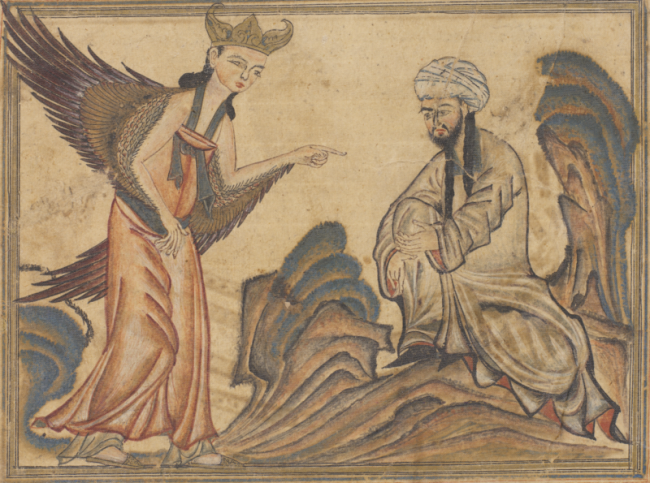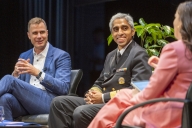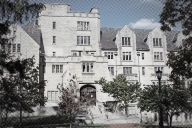You have /5 articles left.
Sign up for a free account or log in.

An image of the painting that upset some Muslim students at Hamline U.
Wikimedia Commons
This fall, an instructor at Hamline University, in Minnesota, was teaching global art history. For one class, the instructor (who has not been named) was discussing Islamic art and included for a brief period (under 10 minutes) a screen image of Muhammad, the founder and prophet of the Muslim faith. The instructor had warned students of her plan.
The image (above) shows Muhammad receiving instruction from the angel Gabriel. The original painting is in a collection at Edinburgh University Library in Scotland.
The reaction to the lesson surprised the instructor and many others. One or more students complained about the image, believing (as many, but not all, Muslims believe) that showing the image was wrong.
“We have learned, over many years, that knowledge can be shared in a multitude of responsible, thoughtful and respectful ways. Our response to the classroom event does not disregard or minimize the importance of academic freedom. It does state that respect, decency, and appreciation of religious and other differences should supersede when we know that what we teach will cause harm,” Fayneese Miller, the university’s president, and David Everett, associate vice president for inclusive excellence, wrote in a letter to the campus on Dec. 9, which was confirmed as reflecting the university’s position.
Letter to the Editor
A reader has submitted
a letter in response to this
article. You can read the
letter here, and view all
of our letters to the editor
here.
“It is not our intent to place blame; rather, it is our intent to note that in the classroom incident—where an image forbidden for Muslims to look upon was projected on a screen and left for many minutes—respect for the observant Muslim students in that classroom should have superseded academic freedom. Many disciplines have embedded within them difficult and controversial theories and material, but as with virtually all subjects, they can be discussed without causing harm. Academic freedom is very important, but it does not have to come at the expense of care and decency toward others,” they added.
The university said that because the instructor was an adjunct, her dismissal was not a firing, as has been said in accounts of the incident in New Lines magazine and Reason.
The New Lines article is by Christiane Gruber, a professor of Islamic art at the University of Michigan.
“As a scholar specializing in Islamic representations of Muhammad … it is my duty to share accurate information about the painting at the heart of the controversy,” Gruber wrote in the piece. “The painting is an authentic and irreplaceable work of art. It is included in one of the earliest Islamic illustrated histories, which often describe the biography of Muhammad and other historical events. The Edinburgh University Library, where the early 14th-century manuscript is preserved, considers the item a masterpiece of Persian book painting and its ‘greatest oriental treasure.’”
She argued that, “In sum, this medieval Islamic painting depicts the beginning of Islam’s holy book and the onset of Muhammad’s divinely ordained apostleship—two themes that the manuscript’s royal Muslim patron and other members of his elite entourage would have been keen to learn about and commemorate during the yearly Ramadan celebrations of the ‘Night of Power’ (‘Laylat al-Qadr’), itself considered the holiest day in the Muslim ritual calendar. The painting no doubt was produced to extol Muhammad’s prophecy and Quranic revelations, making it an Islamophilic artistic endeavor for its painter and viewers. The painting thus falls on the other side of the Islamophobia coin, in both intent and impact.”
The Student Paper
Mark Berkson, chair of the Department of Religion at Hamline, tried to explain the situation in a letter to the editor of The Oracle, the student newspaper.
“The professor gave students both written and verbal notifications that the image would be shown. I don’t know the nature of the conversations that followed, so I am only reflecting on one key question—Is the showing of an image of the Prophet Muhammad in an academic context necessarily an instance of Islamophobia, as has been claimed by some members of the administration?” he wrote.
“I believe that, in the context of an art history classroom, showing an Islamic representation of the Prophet Muhammad, a painting that was done to honor Muhammad and depict an important historical moment, is not an example of Islamophobia. Labeling it this way is not only inaccurate but also takes our attention off of real examples of bigotry and hate,” Berkson added.
He described in the letter how most Muslims do believe that it is immoral to display images of Mohammad, but, he added, “Muslims have created and enjoyed figural representations of Muhammad throughout much of the history of Islam in some parts of the Islamic world. There exist numerous images of Muhammad created by Persian and Turkish artists from the 13th century until today, many of which were miniatures or illustrations in book manuscripts. Some images depict Muhammad with his face obscured with a veil or a halo, but some images show his face.”
Inside Higher Ed is not linking directly to Berkson’s letter, because it was removed two days after it was posted to the newspaper’s website. Berkson sent the letter to Inside Higher Ed and confirmed that a copy available in the Reason link above is accurate.
The Oracle has not responded to Inside Higher Ed about why it removed Berkson’s letter. However, the newspaper published an essay on Christmas Day that explained the decision.
“One of our core tenets, to minimize harm, exists for us to hold ourselves accountable for the way our news affects the lives of individual students, and the Hamline community and student body as a whole. Those in our community have expressed that a letter we published has caused them harm. We have decided, as an editorial board, to take it down,” the essay said. “We are a student publication that is here to provide a space to elevate the voices of students. Our work is of no value if at any time our publication is participating in furthering harm to members of our community.”
Berkson sent another letter to the paper (that hasn’t been published) that said in part, “You also say that my letter makes people feel ‘harmed.’ How precisely does it do that? No controversial images are contained in my letter. There are no slurs, insults, or harmful language. The commentary provides a rational argument backed up by solid and checkable evidence. Are you saying that disagreement with an argument is a form of ‘harm’? I’m sure you realize that this would be the end of open conversation and debate at Hamline. And if you mean that the lack of a response to my article is a form of ‘harm,’ then there is an easy remedy—someone can write a rebuttal. I welcome views that challenge mine and I would like to see the arguments on the other side.”
What the Experts Say
Hamline brought in Jaylani Hussein, executive director of Minnesota’s chapter of the Council on American-Islamic Relations, for a “community conversation” about Islamophobia. Hussein didn’t respond to a request for comment from Inside Higher Ed.
But he told The Twin Cities Pioneer Press that “many of the Muslim students on campus, after they heard of this incident, it impacted them. It impacted their grades, it impacted them finishing off the semester. They obviously were hurt. At the same time, they’re appreciative of the institution doing the right thing.”
He added that “for us Muslims, it is blasphemy,” referring to the art shown in class. “We don’t have any of those images, we don’t share those images, regardless of who drew it … it doesn’t matter. Any depictions of Prophet Muhammad is [sic] frowned upon. It is an act of insult.”
Organizations that focus on free expression in higher education disagreed.
Gregory F. Scholtz, director of the Department of Academic Freedom, Tenure and Governance at the American Association of University Professors, pointed to the AAUP statement “Freedom in the Classroom,” which says, “Ideas that are germane to a subject under discussion in a classroom cannot be censored” because students might be offended. “Instruction cannot proceed in the atmosphere of fear that would be produced were a teacher to become subject to administrative sanction based upon the idiosyncratic reaction of one or more students. This would create a classroom environment inimical to the free and vigorous exchange of ideas necessary for teaching and learning in higher education.”
The Foundation for Individual Rights and Expression issued a statement that called for the reinstatement of the instructor.
“Blanket bans on displaying pedagogically relevant material are not acceptable at a university that commits to academic freedom,” the statement said.
Jeremy Young, senior manager of free expression and education at PEN America, said, “If these reports are accurate, Hamline University has committed one of the most egregious violations of academic freedom in recent memory.”
It’s Happened Before
Issues about religion and academic freedom are not new. And they are not unique to Islam. In the late 1980s, Republicans in Congress cut the budget of the National Endowment for the Arts in a dispute over “Piss Christ,” a photograph of a small plastic crucifix submerged in urine. The work is by Andres Serrano. The controversy grew when the photograph was on display at the Institute of Contemporary Art of the University of Pennsylvania.
One of the most notable examples of the debate in academe concerns the aftermath of the Charlie Hebdo killings. Charlie Hebdo is a French satire and political magazine that has run images of Muhammad periodically over the years. In 2015, two Muslim gunmen stormed the magazine’s offices in Paris and shot dead 12 people.
The University of Minnesota–Twin Cities subsequently held a panel discussion entitled, “Can One Laugh at Everything? Satire and Free Speech After Charlie.” The panel itself wasn’t attacked, but the poster used to promote the event (at right) was.
Muslim students complained about the poster, which used an image from the magazine.
The university investigated the students’ concerns and issued a report that questioned the judgment of those who signed off on the posters. And university administrators sent an email to conference organizers that some interpreted as an order to remove the posters, although the university disputes this.








